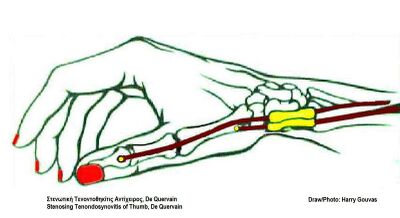Wrist Hyperflexion and Abduction of the Thumb (WHAT) Test: Difference between revisions
Trista Chan (talk | contribs) m (Trista Chan moved page Wrist Hyperflexion & Abduction of the Thumb (WHAT) Test to Wrist Hyperflexion and Abduction of the Thumb (WHAT) Test: title amend) |
No edit summary |
||
| Line 12: | Line 12: | ||
</ref>, thus the Wrist hyperflexion & Abduction of the Thumb test is developed in 2014 as an alternative test for De Quervain's disease<ref name=":1" />. The WHAT test being an active test, it better isolates the AbPL & EPB tendons and eliminates the excursion mechanism of the tendons<ref name=":1" />. | </ref>, thus the Wrist hyperflexion & Abduction of the Thumb test is developed in 2014 as an alternative test for De Quervain's disease<ref name=":1" />. The WHAT test being an active test, it better isolates the AbPL & EPB tendons and eliminates the excursion mechanism of the tendons<ref name=":1" />. | ||
[[File:Stenosing tendondosynvitis of thumb De Quervain.jpg|center|frameless|400x400px| | [[File:Stenosing tendondosynvitis of thumb De Quervain.jpg|center|frameless|400x400px| | ||
</ref>]] | </ref>]] | ||
Revision as of 07:56, 28 June 2023
Purpose[edit | edit source]
De Quervain's Tenosynovitis is a condition involving the abductor pollicis longus (AbPL) and extensor pollicis brevis (EPB) tendons in the first extensor compartment of the wrist[1]. Different tests has been used to identify De Quervain's disease, with the Finkelstein's test being one of the common diagnostic tests[2]. The Finkelstein's test is often confused with the Eichhoff's test[2][3], thus the Wrist hyperflexion & Abduction of the Thumb test is developed in 2014 as an alternative test for De Quervain's disease[3]. The WHAT test being an active test, it better isolates the AbPL & EPB tendons and eliminates the excursion mechanism of the tendons[3].
Technique[edit | edit source]
Procedure[3]:[edit | edit source]
- The patient is seated in a comfortable position.
- They are asked to actively hyperflex their wrist and abduct their thumb.
- The examiner then resists the movement with their index finger.
Interpretation[3]:[edit | edit source]
Pain reproduction indicates positive test for De Quervain's Tenosynovitis
Evidence[edit | edit source]
A study found that The WHAT test is more accurate as compared to traditional diagnostic test for De Quervain's, with a sensitivity score of 0.99 and specificity score of 0.29[3].However, the study involved a small sample size and only two experienced surgeons. Therefore, further investigations need to be done to confirm the reliability and validity of the test[3].
References[edit | edit source]
- ↑ Satteson E, Tannan SC. De Quervain Tenosynovitis [Internet]. PubMed. Treasure Island (FL): StatPearls Publishing; 2020. Available from: https://www.ncbi.nlm.nih.gov/books/NBK442005/
- ↑ 2.0 2.1 Wu F, Rajpura A, Sandher D. Finkelstein’s Test Is Superior to Eichhoff’s Test in the Investigation of de Quervain’s Disease. Journal of Hand and Microsurgery [Internet]. 2018 Aug 1;10(2):116–8. Available from: https://pubmed.ncbi.nlm.nih.gov/30154628/
- ↑ 3.0 3.1 3.2 3.3 3.4 3.5 3.6 Goubau JF, Goubau L, Van Tongel A, Van Hoonacker P, Kerckhove D, Berghs B. The wrist hyperflexion and abduction of the thumb (WHAT) test: a more specific and sensitive test to diagnose de Quervain tenosynovitis than the Eichhoff’s Test. Journal of Hand Surgery (European Volume). 2013 Jan 22;39(3):286–92.
- ↑ www.youtube.com. (n.d.). Wrist Hyperflexion Abduction of the Thumb / WHAT Test | De Quervain’s Disease. [online] Available at: https://www.youtube.com/watch?v=FlFMFhrbWwM [Accessed 27 Jun. 2023].







